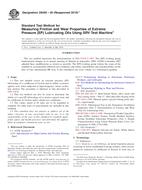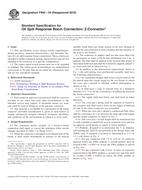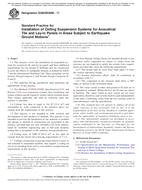1.1 This guide is a tool to aid in the choice of an oil for precision rolling element bearing applications. There are two areas where this guide should have the greatest impact: (1) when a lubricant is being chosen for a new bearing application and (2) when a lubricant for a bearing has to be replaced because the original lubricant specified for the bearing can no longer be obtained. The Report (Section 5) contains a series of tests performed by the same laboratory on a wide variety of oils commonly used in bearing applications to allow comparisons of those properties of the oil that the committee thought to be most important when making a choice of lubricant. This guide contains a listing of the properties of oils by chemical type, that is, ester, silicone, and so forth. This organization is necessary since the operational requirements in a particular bearing application may limit the choice of lubricant to a particular chemical type due to its temperature stability, viscosity index or temperature-vapor pressure characteristics, and so forth. The Report includes the results of tests on the oils included in this study. The Report recommends replacement lubricants for those oils tested that are no longer available. The Report also includes a glossary of terms used in describing/discussing the lubrication of precision and instrument bearings. The Report presents a discussion of elastohydrodynamic lubrication as applied to rolling element bearings.
1.2 Although other compendia of lubricant properties have been published, for example, the Barden Product Standard, Lubricants and the NASA Lubricant Handbook for the Space Industry, none have centered their attention on lubricants commonly used in precision rolling element bearings (PREB). The PREB put a host of unique requirements upon a lubricant. The lubricant must operate at both high and low temperatures. The lubricant must provide lubrication for months, if not years, without replenishment. The lubricant must be able to support high loads but cannot be so viscous that it will interfere with the operation of the bearing at very high speeds or low temperatures, or both. The lubricant must provide boundary lubrication during low-speed or intermittent operation of the bearing. And, in many applications, its vapor pressure must be low enough under operating conditions that evaporative losses do not lead to lubricant depletion or contamination of nearby components. These and other considerations dictated the series of tests that were performed on each lubricant included in this study.
1.3 Another important consideration was encompassed in this study. Almost all of the testing was performed by the same laboratory, The Petroleum Products Research Department of the Southwest Research Institute in San Antonio, Texas, using ASTM procedures. This continuity of testing should form a solid basis for comparing the properties of the multitude of lubricants tested by avoiding some of the variability introduced when lubricants are tested by different laboratories using different or even the “same” procedures.
1.4 It should be noted that no functional tests (that is, bearing tests) were performed. The results of the four-ball wear test give some comparison, “a figure of merit,” of the lubrication properties of the oils under the condition of this test. But experience has shown that testing the lubricant in running bearings is the best means of determining lubricant performance.
Product Details
- Published:
- 12/10/2001
- Number of Pages:
- 14
- File Size:
- 1 file , 290 KB


